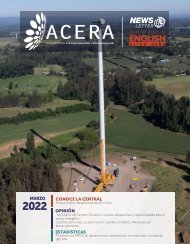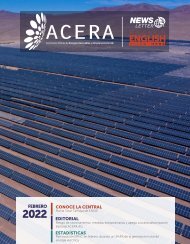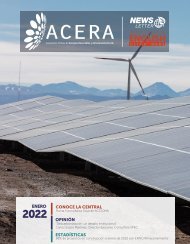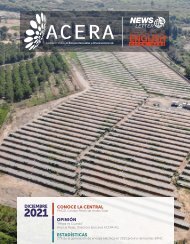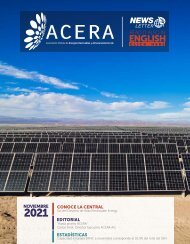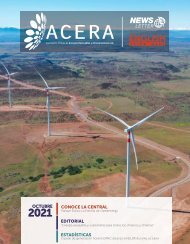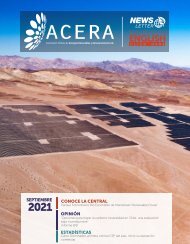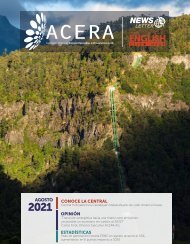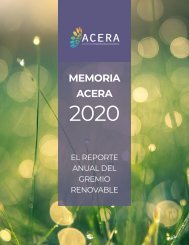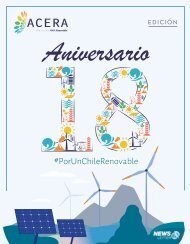Create successful ePaper yourself
Turn your PDF publications into a flip-book with our unique Google optimized e-Paper software.
CENTRO DE PILOTAJE Y ENTRENAMIENTO -<br />
PLATAFORMA SOLAR DEL DESIERTO DE ATACAMA<br />
Tecnología: Solar FV - Monocristalino, Policristalino, Capa Fina<br />
(cdTe), BiPV<br />
Entidad a Cargo del Proyecto: SercChile - Universidad de<br />
Antofagasta<br />
Potencia Instalada: 30 kWp<br />
Sistema al que Inyecta: Sistema Aislado<br />
Otras empresas involucradas en el Proyecto: CDEA, First Solar,<br />
Tecnalia y Fraunhofer.<br />
EDITORIAL<br />
ERNC: Los hechos son los que hablan<br />
DICIEMBRE<br />
NEW!<br />
READ IT ALSO<br />
IN ENGLISH<br />
CLICK HERE<br />
NOTICIAS<br />
Nuevo comité <strong>ACERA</strong>: “Generación Distribuida y Generación Residencial”<br />
Chile sube al segundo lugar en ranking de renovables a nivel mundial<br />
Un nuevo Ingeniero de Estudios para <strong>ACERA</strong><br />
ESTADÍSTICAS<br />
Dos proyectos Minihidro y cuatro Solares Fotovoltaicos comienzan construcción<br />
CONOCE A NUESTROS SOCIOS<br />
Fontaine & CIA Abogados<br />
Solaire Direct
EDITORIAL<br />
Carlos Finat<br />
Director Ejecutivo<br />
ERNC: Los hechos son los que hablan<br />
“Con esas energías primitivas, de menor dimensión y fuerza,<br />
se está condenando a actividades más pequeñitas. Puede<br />
hacer funcionar una licuadora, pero no una fábrica enorme o<br />
una minera o si lo hace será a costos inmensos”. Así se<br />
refería a las ERNC en una nota del diario El Mercurio el ex<br />
presidente peruano Alan García, de visita en Chile por<br />
invitación de un proyecto hidroeléctrico de gran escala en el<br />
año 2013. Un memorable episodio previo a la explosión<br />
renovable que ahora conocemos.<br />
Más allá de querer juzgar las capacidades del referido<br />
personero sobre su análisis y proyección sobre el futuro del<br />
desarrollo energético, lo anterior constituye un ejemplo claro<br />
de los cuestionamientos contra las ERNC a los que han<br />
debido enfrentarse en la corta historia de estas energías en<br />
Chile.<br />
que se ha encargado de demostrar lo inexacto de muchas<br />
de las críticas a las ERNC. A fines de <strong>2016</strong>, Chile cuenta con<br />
una capacidad instalada de 3970 MW en centrales ERNC,<br />
que al pasado mes de noviembre aportaron el 16,05% de la<br />
generación total. La participación de estos generadores en<br />
las licitaciones de energía para distribuidoras fue la razón<br />
para la fuerte baja de los precios en ese proceso, y un efecto<br />
similar se observa en licitaciones privadas, como es el caso<br />
de la subasta conjunta recientemente realizada por un grupo<br />
de empresas industriales en la octava región.<br />
Actualmente, vemos nuevas objeciones que están siendo<br />
esgrimidas en contra estas tecnologías. Que necesitan<br />
respaldo y que por ello se requeriría más energía de grandes<br />
hidroeléctricas o termoeléctricas o que los proyectos ERNC<br />
no serían sustentables con los precios actuales.<br />
Durante los últimos años las ERNC han tenido que<br />
enfrentarse a diferentes voces que señalaban que éstas<br />
serían muy caras, que los proyectos no se construirían, que<br />
la variabilidad de algunas de ellas acarrearía graves efectos<br />
a los sistemas eléctricos y que los recursos naturales de<br />
Chile no serían tan buenos, por mencionar sólo algunos.<br />
Las respuestas a esos cuestionamientos han estado<br />
oportunamente disponibles a través de diferentes estudios<br />
nacionales, realizados por instituciones de gobierno (Mesa<br />
ERNC), CDEC-SING y por <strong>ACERA</strong> (o por consultoras<br />
encargadas por la asociación), entre otras. También, la<br />
experiencia internacional ha aportado evidencia pública de<br />
experiencias y antecedentes que continuamente han<br />
respaldado la creciente eficiencia técnica y económica del<br />
desarrollo de las ERNC como fuente de suministro eléctrico.<br />
Más allá de las proyecciones, ha sido la propia realidad la<br />
El sector ERNC ha demostrado sistemáticamente -y con<br />
hechos- su capacidad de superar los mitos que se han<br />
intentado crear en torno a él. Más aún, las ERNC han traído<br />
al sector eléctrico un nivel de competencia nunca antes visto<br />
en la historia de esta industria en el país.<br />
Los desarrolladores de centrales solares, eólicas, de<br />
biomasa y biogás, pequeñas hidroeléctricas y geotermia<br />
tienen la certeza de estar transitando por la senda correcta,<br />
que proporcionará una matriz energética cada vez más<br />
segura, competitiva y sustentable. Para ello, de parte de las<br />
autoridades, esperamos que se mantengan los lineamientos<br />
de la política energética que tan buenos resultados ha<br />
mostrado hasta el momento.<br />
En paralelo, los hechos seguirán avalando la importancia de<br />
estas tecnologías para Chile y el planeta.
NOTICIAS<br />
BALANCE ERNC: <strong>ACERA</strong> REALIZA SU CONFERENCIA<br />
DE PRENSA ANUAL<br />
Tras un año marcado por el avance de las ERNC, y como ya es habitual cada año,<br />
<strong>ACERA</strong> realizó durante los primeros días de enero su Conferencia de Prensa<br />
Anual, a la cual asistieron periodistas, tanto de medios especializados como de<br />
cobertura nacional. La actividad contó con la participación del Presidente de<br />
<strong>ACERA</strong>, José Ignacio Escobar y de su Director Ejecutivo, Carlos Finat, quienes<br />
centraron la presentación en las conclusiones <strong>2016</strong>, además de las metas y<br />
proyecciones del sector renovable para el año 2017. Sobre los desafíos futuros y<br />
la tarea de mantener la Política Energética de Largo Plazo, el Director Ejecutivo<br />
de <strong>ACERA</strong> señaló que “aún tenemos un desafío por delante como sector<br />
eléctrico y es seguir avanzando y desarrollando la Política Energética. Este<br />
documento, creado de manera totalmente participativa, representa un desafío<br />
concreto para el sector eléctrico, que implica también diferentes tareas por<br />
realizar por parte de todos los que lo conformamos. Es necesaria la continuidad<br />
de la Política para el crecimiento y desarrollo del sector y el país”.<br />
CHILE SUBE AL SEGUNDO LUGAR EN RANKING DE<br />
RENOVABLES A NIVEL MUNDIAL<br />
Según el ranking “Climatescope” que elabora Bloomberg junto al Banco<br />
Interamericano de Desarrollo (BID) y que evalúa la competitividad de 58<br />
naciones emergentes en materia de inversión en energías limpias, Chile<br />
ocupa el segundo lugar a nivel mundial, sólo superado por China, y el primer<br />
lugar en América Latina y el Caribe. En la primera medición en 2014, nuestro<br />
país ocupó el quinto lugar a nivel latinoamericano, subiendo el año siguiente<br />
al segundo lugar. Carlos Finat, Director Ejecutivo de <strong>ACERA</strong> señala al<br />
respecto que “las razones por las que Chile llega a este puesto son<br />
fundamentalmente dos. La primera, es la fuerte inversión que ha atraído el<br />
sector ERNC, que Bloomberg estima en 3,3 billones de US $ y, en segundo<br />
lugar, está el reconocimiento del esfuerzo que está haciendo Chile por<br />
desarrollar una política y acciones concretas para una economía baja en<br />
carbono, aspecto en el cual las ERNC son fundamentales”.
NOTICIAS<br />
NUEVO COMITÉ <strong>ACERA</strong>: “GENERACIÓN DISTRIBUIDA<br />
Y GENERACIÓN RESIDENCIAL”<br />
Durante el mes de diciembre, <strong>ACERA</strong> realizó la primera sesión del comité<br />
“Generación Distribuida y Generación Residencial”, el cual tiene como propósito<br />
-en una primera instancia- identificar las materias de interés para los socios en<br />
esta materia, enfatizando en la regulación y normas, relación con autoridades y<br />
con el público, además de compartir experiencias técnicas. En la ocasión se<br />
realizó un listado sobre las temáticas que serán abarcadas en el comité, dentro<br />
de las cuales se encuentra la Tramitación de permisos, la Ley de Distribución<br />
2017 y Permisos de conexión PMGD, entro otros. Este comité es parte de las<br />
nuevas actividades que realizará <strong>ACERA</strong> durante 2017 y que esperar ser un<br />
aporte en el ámbito técnico de la asociación.<br />
TU EMPRESA<br />
PODRÍA ESTAR<br />
AQUÍ<br />
MEDIA PÁGINA HORIZONTAL<br />
Contacto<br />
Paula Vicens<br />
paula.vicens@acera.cl<br />
+562 22363348
Ahorre<br />
$200<br />
antes del 27 de enero.<br />
NOTICIAS<br />
Chile<br />
Energy &<br />
Infrastructure<br />
Finance<br />
Forum 2017<br />
May 3 rd 2017<br />
Ritz-Carlton, Santiago,<br />
Chile<br />
UN NUEVO INGENIERO DE ESTUDIOS EN <strong>ACERA</strong><br />
Recientemente se unió al gremio Felipe Gallardo, quien<br />
ocupará el cargo de Ingeniero de Estudios en la Asociación.<br />
Explorando las nuevas<br />
oportunidades y retos<br />
de Chile en relación<br />
<br />
infraestructura y energía<br />
Platinum Sponsor<br />
Gold Sponsor<br />
Felipe fue parte de <strong>ACERA</strong> de forma temporal durante un<br />
periodo de transición interna, es Ingeniero Civil en<br />
Electricidad de la Universidad de Santiago de Chile, y está<br />
familiarizado con la industria, ya que realizó su práctica<br />
profesional en la Gerencia Técnica Regional de Chilectra<br />
(hoy Enel Distribución), además de participar, a través de la<br />
empresa MVidaurre, en el proyecto Rancagua-Express de<br />
EFE.<br />
Con su llegada, <strong>ACERA</strong> espera intensificar y potenciar su<br />
trabajo y análisis técnico sobre el sector energético de<br />
Chile, tal como lo ha hecho hasta ahora. Les dejamos su<br />
correo para que se pongan en contacto:<br />
Felipe.gallardo@acera.cl<br />
Supporting Partners<br />
#CEIFF17<br />
euromoneyseminars.com/CEIFF17
ESTADÍSTICAS<br />
RESULTADOS ERNC<br />
Durante el mes de diciembre de <strong>2016</strong>, el Servicio de Evaluación Ambiental aprobó cinco proyectos ERNC basados en tecnología Solar Fotovoltaica (FV) (246 MW),<br />
de los cuales uno considera, adicionalmente, la instalación de tecnología Solar CSP (70 MW), totalizando 316 MW aprobados durante el mes. Entre los proyectos<br />
aprobados, está la Planta FV “Almeyda”, de Acciona (60 MW), y el Proyecto FV “Santa Marta de Marchigüe”, de Mainstream RP (95 MW).<br />
Por otra parte, no se registraron proyectos ERNC admitidos a calificación durante diciembre.<br />
En la resolución exenta número 904 del 26 de diciembre de <strong>2016</strong>, publicada por la Comisión Nacional de Energía - CNE, se declararon seis nuevos proyectos<br />
ERNC en construcción, totalizando 62,8 MW. Cuatro corresponden a centrales FV de Socios de <strong>ACERA</strong>: “Puerto Seco Solar”, de SolarPack (9 MW), “Cintac”, de<br />
la empresa del mismo nombre (2,5 MW) y “La Esperanza” (9 MW) y “Marchigüe” (9 MW), ambas de Grenergy. Los otros proyectos corresponden a dos centrales<br />
Mini-hidro de pasada (30,19 MW).<br />
Además, en dicho documento se anunció que el Proyecto FV “Sierra Gorda”, de Enel Green Power (112 MW), y “San Juan III”, de Latin American Power (29,7 MW),<br />
entraron en periodo de pruebas.<br />
Finalmente, en el <strong>Newsletter</strong> de la Dirección de Operaciones del CDEC-SIC, del 19 de diciembre de <strong>2016</strong>, se informó de la entrada en operación de dos centrales<br />
PMGD solares (4 MW) y un proyecto PMGD Mini-Hidro (3MW). Además, el proyecto “Parque Eólico San Pedro II”, de Transantartic (65 MW) entró en pruebas.<br />
PROYECTOS ERNC POR ESTADO DE AVANCE<br />
12.000<br />
10.000<br />
Tipo de Tecnología<br />
Potencia (MW)<br />
En operación En construcción Aprobado En calificación Total<br />
8.000<br />
Energía Eólica<br />
1.424<br />
122<br />
6.942<br />
2.295<br />
10.783<br />
6.000<br />
Solar PV<br />
CSP<br />
1.611<br />
0<br />
1.385<br />
110<br />
11.640<br />
1.292<br />
4.418<br />
1.515<br />
19.054<br />
2.917<br />
4.000<br />
2.000<br />
0<br />
Energía Eólica Solar PV CSP Bioenergía Geotérmica Mini hidro ERNC PSH Termosolar<br />
Bioenergía<br />
Geotérmica<br />
Mini hidro ERNC<br />
PSH (Pumped<br />
storage hydro)<br />
Termosolar<br />
Total<br />
481<br />
0<br />
600<br />
0<br />
0<br />
48<br />
55<br />
0<br />
171<br />
70<br />
304<br />
300<br />
90<br />
50<br />
124<br />
0<br />
742<br />
168<br />
1.082<br />
300<br />
39 0 0 0 39<br />
4.154 1.719 20.719 8.492 35.085<br />
Potencia de proyectos en operación (MW)<br />
Potencia de proyectos aprobados (MW)<br />
Potencia de proyectos en construcción (MW)<br />
Potencia de proyectos en calificación (MW)<br />
POTENCIA ERNC INSTALADA Y EN CONSTRUCCIÓN POR SISTEMA<br />
Potencia instalada SIC (MW)<br />
Potencia instalada SING (MW)<br />
Mini hidro ERNC 555<br />
Solar PV 1.238<br />
Mini hidro ERNC<br />
Solar PV<br />
16<br />
365<br />
Energía Eólica<br />
1.214<br />
Energía Eólica<br />
202<br />
Bioenergía<br />
481<br />
Potencia en construcción SIC (MW)<br />
Potencia en construcción SING (MW)<br />
Mini hidro ERNC<br />
55<br />
Solar PV<br />
739<br />
Solar PV<br />
646<br />
CSP<br />
110<br />
Energía Eólica<br />
122<br />
Geotérmica<br />
48<br />
Energía Eólica<br />
Solar PV CSP Bioenergía Geotérmica Mini Hidro
ESTADÍSTICAS<br />
Durante noviembre de <strong>2016</strong>, las ERNC aportaron un 14,23% de la energía total del sistema, lo que acumula un 12,25% en lo que va del año.<br />
La energía solar fue la que más contribuyó con un 5,2%, lo que significó un aumento del 8,01% con respecto a la generación del mes anterior. Le siguió la energía<br />
eólica con un 3,89%, disminuyendo un 11,62% con respecto al mes de octubre del <strong>2016</strong>. La energía proveniente de centrales mini-hidro estuvo en tercer lugar con<br />
2,97%, representando un decremento del 4,48%. Finalmente, estuvo la bioenergía, con un 2,17%, con una disminución del 39,16% con respecto a octubre del<br />
<strong>2016</strong>.<br />
PORCENTAJE DE PARTICIPACIÓN DE LAS ERNC EN EL SISTEMA<br />
16%<br />
14%<br />
12%<br />
10%<br />
8%<br />
6%<br />
4%<br />
2%<br />
2012 2013 2014 2015 dic.15 ene.16 feb.16 mar.16 abr.16 may.16 jun.16 jul.16 ago.16 sept.16 oct.16 nov.16<br />
Solar Eólico Bioenergía Mini Hidro Total Reconocido Obligación<br />
Porcentaje de participación ERNC Noviembre <strong>2016</strong> <strong>2016</strong> YTD<br />
Reconocido<br />
12,95%<br />
Obligación<br />
4,09%<br />
Bioenergía 2,17%<br />
10,05%<br />
4,20%<br />
3,48%<br />
Eólica<br />
3,89%<br />
3,08%<br />
Hidraúlica<br />
2,97%<br />
2,35%<br />
Solar<br />
5,20%<br />
3,33%<br />
Total<br />
14,23%<br />
12,25%<br />
La información de éste gráfico está desfasada en dos meses.<br />
Fuente de gráficos: Elaboración propia en base a información de CNE, CDEC-SIC, CDEC-SING y SEIA.<br />
BIENVENIDA A LOS<br />
NUEVOS SOCIOS
CONOCIENDO A NUESTROS SOCIOS<br />
Carolina Seeger Caerols<br />
ABOGADO<br />
cseeger@fontaineycia.cl<br />
Carolina es chilena, soltera y abogado con experiencia relevante en Derecho<br />
de Aguas y Eléctrico. Autora del libro “Derecho Eléctrico” y de diversas<br />
publicaciones en revistas especializadas en materias regulatorias.<br />
¿Cuáles son los productos o servicios que entrega su empresa y hacia qué tipo(s)<br />
de ERNC?<br />
Actualmente participamos en el desarrollo de proyectos hidroeléctricos y<br />
fotovoltaicos que califican como PMG y PMGD. El servicio de asesoría jurídica al<br />
cliente es integral, abordando las materias inmobiliarias, corporativas, tributarias,<br />
ambientales, de regulación eléctrica y recursos naturales.<br />
¿Cuáles son las novedades o cambios de su empresa en el último tiempo?<br />
Hemos ido creciendo en tamaño, lo que nos ha permitido abarcar paralelamente<br />
la asesoría de proyectos muy diversos. Por otra parte, se impulsa a los abogados<br />
a realizar estudios de perfeccionamiento que permitan brindar un servicio de la<br />
mejor calidad.<br />
¿Cuáles son los principales proyectos -o temas- que están trabajando en el<br />
último tiempo en torno a las ERNC o el medioambiente? En caso de ser plantas<br />
de generación, ¿dónde se ubican? ¿Cuáles son sus características centrales?<br />
Prestamos servicios para el emplazamiento de una central de pasada con<br />
embalse de 17 MW en la IX Región, un sector con presencia de comunidades<br />
indígenas, y en la V Región asesoramos un proyecto fotovoltaico de 3 MW, en la<br />
obtención de permisos de modificación de cauce y municipales, conexión<br />
eléctrica a redes de distribución, y contratos EPC y O&M.<br />
¿Qué elementos caracterizan y/o diferencian a su empresa?<br />
El compromiso con el cliente y con el proyecto, y la búsqueda de la excelencia en<br />
el servicio.<br />
¿Cuál considera que es la importancia de la participación ERNC en el sistema<br />
eléctrico del país?<br />
Las ERNC aportan en la disminución de gases de efecto invernadero (GEI) y<br />
contribuyen para lograr una matriz energética diversa, que permita avanzar hacia<br />
una mayor independencia ante factores de disponibilidad y precios de<br />
combustibles extranjeros. Asimismo, constituyen un fomento al desarrollo de la<br />
tecnología a nivel local.<br />
¿Por qué recomendaría ser socio de <strong>ACERA</strong>?<br />
Porque es la principal agrupación en Chile que reúne a los actores del mercado<br />
de las Energías Renovables y porque constituye una plataforma adecuada para<br />
discutir la aplicación de la regulación vigente, como -asimismo- plantear la<br />
necesidad de modificaciones o nuevas regulaciones.<br />
Nicolás Sadon<br />
GERENTE GENERAL<br />
mnunez@solairedirect.fr<br />
Nicolás es licenciado de la Universidad de Ciencias Políticas de<br />
Aix-en-Provence y es MBA de la escuela de Management de Lyon en Francia.<br />
Es uno de los siete socios fundadores del grupo Solairedirect, creado hace<br />
más de 10 años en Francia. Tras sus estudios y antes de fundar Solairedirect,<br />
Nicolas trabajó como consultor y como diplomático para el Estado francés<br />
en África.<br />
¿Cuáles son los productos o servicios que entrega su empresa y hacia qué tipo(s)<br />
de ERNC?<br />
Somos una empresa chilena de matriz francesa especializada en el desarrollo,<br />
financiamiento, construcción y operación de plantas fotovoltaicas. Contamos con<br />
dos proyectos en operación en Chile: “Andacollo” y “Los Loros”.<br />
¿Cuáles son las novedades o cambios de su empresa en el último tiempo?<br />
Solairedirect fue adquirida recientemente por el grupo Engie y estamos<br />
trabajando en esa integración. Además, hace poco firmamos un acuerdo de<br />
colaboración con EECL para el desarrollo de 400 MW en Chile para los próximos<br />
cuatro años.<br />
¿Cuáles son los principales proyectos -o temas- que están trabajando en el<br />
último tiempo en torno a las ERNC o el medioambiente? En caso de ser plantas<br />
de generación, ¿dónde se ubican? ¿Cuáles son sus características centrales?<br />
Nuestra planta de Andacollo (1,3 MW) situada en la IV Región, opera desde 2013,<br />
siendo la primera conectada al SIC. Los Loros, de mayor potencia (54 MW), en la<br />
III Región, comenzó su operación en <strong>2016</strong>. Además, contamos con un extenso<br />
pipeline de proyectos en desarrollo a lo largo del país.<br />
¿Qué elementos caracterizan y/o diferencian a su empresa?<br />
Llevamos más de 10 años desarrollando y construyendo proyectos de energía<br />
solar fotovoltaica en diversas geografías, con una sola obsesión: suministrar el<br />
MWh solar lo más competitivo posible. Somos líderes del sector y nos<br />
caracterizamos por la competitividad. En las licitaciones celebradas a nivel<br />
mundial en los últimos dos años, tenemos un rango de éxito superior al 50%.<br />
¿Cuál considera que es la importancia de la participación ERNC en el sistema<br />
eléctrico del país?<br />
Chile es un país pionero en ERNC en Latinoamérica. La matriz energética chilena<br />
está conformada en gran parte por ERNC y éste es un proceso imparable. Su<br />
aporte está contribuyendo a reducir las emisiones contaminantes y los precios de<br />
la energía.<br />
¿Por qué recomendaría ser socio de <strong>ACERA</strong>?<br />
<strong>ACERA</strong> ha permitido integrarnos en el rubro de la energía fácilmente. Estar en<br />
contacto con otros actores del sector e interactuar con ellos en temas de mutuo<br />
interés. Además, es importante ser parte de la asociación líder para trabajar<br />
juntos y coordinados para conseguir objetivos comunes.
EVENTOS<br />
ENERO<br />
EVENTOS DEL MES<br />
11<br />
Desayuno DIE: Academia e Industria<br />
Departamento de Ingeniería Eléctrica de la Universidad de Chile - DIE<br />
Santiago<br />
Revisar aquí<br />
12<br />
How Political Commitment Drieves the STE/CSP Deployement Worldwide<br />
Estela Solar<br />
Bélgica<br />
Revisar aquí<br />
17<br />
Asamblea Ordinaria de Socios <strong>ACERA</strong><br />
<strong>ACERA</strong><br />
Santiago<br />
Revisar aquí<br />
MARZO<br />
EVENTOS DEL MES<br />
08 al 10<br />
Growing Economies Energy Forum<br />
EnergyNet Ltd.<br />
Estados Unidos<br />
Revisar aquí<br />
14<br />
Cena Anual de las ERNC<br />
<strong>ACERA</strong><br />
Santiago<br />
Revisar aquí
<strong>ACERA</strong>, Asociación Chilena de<br />
Energías Renovables A.G.<br />
General del Canto 230, Of 601<br />
Providencia, Santiago<br />
+562 2236 3348<br />
informaciones@acera.cl<br />
@<strong>ACERA</strong>AG<br />
<strong>ACERA</strong>
PILOT PROJECTS AND TRAINING CENTER –<br />
ATACAMA DESERT SOLAR PLATFORM<br />
Technology: Solar PV - Monocrystallin, Policrystallin, Thin Film (cdTe), BiPV<br />
Entity in charge of the Project: SercChile - Universidad de Antofagasta<br />
Installed Power: 30 kWp<br />
Injection Grid: Isolated Installation<br />
Other companies involved in the Project: CDEA, First Solar, Tecnalia and Fraunhofer.<br />
EDITORIAL<br />
NCRE: Facts speak for themselves<br />
NEWS<br />
New <strong>ACERA</strong> committee: “Distributed Generation and Residential Generation”<br />
Chile climbs to the second position in the renewable energies global ranking<br />
A new Studies Engineer in <strong>ACERA</strong><br />
DECEMBER<br />
STATISTICS<br />
Two Mini hydro and four Photovoltaic solar projects begin their construction<br />
MEET OUR MEMBERS<br />
Fontaine & CIA<br />
Solaire Direct
EDITORIAL<br />
Carlos Finat<br />
Executive Director<br />
NCRE: Facts speak for themselves<br />
“Those primitive energies, of smaller dimension and strength,<br />
are meant for smaller activities. They can run a blender, but<br />
not a huge factory or a mining company. And if they do, it<br />
will be at immense costs”. This is the way the former<br />
president of Peru, Alan García, referred to NCRE in an<br />
interview with the El Mercurio newspaper during a visit to<br />
Chile, invited by a large-scale hydroelectric project in 2013.<br />
A memorable incident prior to the renewable explosion we<br />
see nowadays.<br />
Beyond projections, reality itself has proved how inaccurate<br />
most criticisms towards NCRE have been. By the end of<br />
<strong>2016</strong>, Chile has an installed capacity of 3970 MW in NCRE<br />
plants, which by last November contributed 16.05% of total<br />
generation. The participation of those generators in power<br />
bids for distributors was the reason for the strong decrease<br />
of prices in that process. A similar effect can be seen in<br />
private tenders, such as the joint auction carried out recently<br />
by a group of industrial companies in the eighth region.<br />
Beyond judging the capabilities of the above mentioned<br />
statesman concerning the analysis and projection of the<br />
future of energy development, this is a clear example of the<br />
questioning the NCRE have had to face over the short<br />
history of these energies in Chile.<br />
At present, new objections are being raised against these<br />
technologies. That they need backup and therefore more<br />
energy would be required from big hydro and thermoelectric<br />
plants, or that NCRE projects will not be sustainable with<br />
current prices.<br />
During the last few years, the NCRE have had to deal with<br />
different voices that stated that they would be very<br />
expensive, that the projects would not be built, that the<br />
variability of some of them would bring serious effects for<br />
electric systems and that Chilean natural resources were not<br />
good enough, just to mention some of them.<br />
The answers to those questionings have been duly available<br />
through different national surveys performed by<br />
governmental institutions (NCRE Panel), CDEC-SING and<br />
<strong>ACERA</strong> (or consulting firms designated by the association),<br />
among others. International experience has also provided<br />
public evidence that has constantly supported the ever<br />
growing technical and economic efficiency of NCRE’s as a<br />
source of electric supply.<br />
The NCRE sector has systematically proved -with facts- its<br />
capability to overcome the myths that have been created<br />
around it. What is more, NCRE have introduced to the<br />
electric sector a competitive pressure that has never been<br />
seen before in the history of this industry in Chile.<br />
Developers of solar and wind parks, biomass and biogas<br />
plants, as well as small hydro and geothermal plants, are<br />
sure of following the right path, which leads to a more<br />
secure, more competitive and more sustainable energy<br />
matrix. To this end, we hope the guidelines of Energy Policy<br />
will be maintained, which have shown such good results by<br />
now for the whole country.<br />
In parallel, facts will keep endorsing the high relevance of<br />
these technologies in Chile and the planet.
NEWS<br />
NCRE BALANCE: <strong>ACERA</strong> HELD ITS ANNUAL PRESS<br />
CONFERENCE<br />
After a year marked by NCRE improvement, and as it is already usual every<br />
year, on the first days of January <strong>ACERA</strong> gave its Annual Press Conference<br />
which was attended by different journalists, both from specialized and<br />
national coverage media. The activity counted with the presence of <strong>ACERA</strong>’s<br />
President, José Ignacio Escobar, and its Executive Director, Carlos Finat,<br />
whose speeches were centered on <strong>2016</strong> conclusions and on the goals and<br />
projections of the renewable sector for 2017. Regarding future challenges<br />
and the task of maintaining the Long-Term Energy Policy, <strong>ACERA</strong>’s Executive<br />
Director stated that “we still have a challenge ahead as an electricity sector<br />
and is to continue advancing and developing the Energy Policy. This policy,<br />
created in a totally participative way, represents a concrete challenge for the<br />
electric sector, which involves different tasks to be carried out by all those<br />
who are part of it. It is necessary the continuity of the Policy for the growth<br />
and development of the sector and the country "<br />
CHILE CLIMBS TO THE SECOND POSITION IN THE RENEWABLE<br />
ENERGIES GLOBAL RANKING<br />
According to the “Climatescope” ranking prepared by Bloomberg together<br />
with the Inter-American Development Bank (BID), which assesses the<br />
competitiveness of 58 emerging nations in terms of clean energy investment,<br />
Chile is placed second on a global level, just behind China, and first in Latin<br />
America and the Caribbean. In the first measurement in 2014, our country<br />
was placed fifth on a Latin-American level, rising to the second place in<br />
2015. In the opinion of Carlos Finat, <strong>ACERA</strong>’s Executive Director, “there are<br />
mainly two reasons for this. In the first place, the strong investment<br />
attracted by the NCRE sector, estimated at USD 3.3 billion, and in the<br />
second place, the recognition of the effort made by Chile to develop a policy<br />
and concrete actions for a carbon-low economy, where NCRE play a<br />
fundamental part.”
NEWS<br />
NEW <strong>ACERA</strong> COMMITTEE: “DISTRIBUTED<br />
GENERATION AND RESIDENTIAL GENERATION”<br />
During the month of December, <strong>ACERA</strong> carried out the first session of the<br />
“Distributed Generation and Residential Generation” committee, whose purpose<br />
-in the first instance- is to identify the issues of particular interest for the members<br />
in this area, especially concerning regulations and standards, relation with the<br />
authorities and the public, as well as to share technical experiences. A list of<br />
issues to be treated by the committees was prepared, which include licences<br />
processing, the 2017 Law of Distribution and PMGD connection licences, among<br />
others. This committee is part of the new activities <strong>ACERA</strong> will be carrying out in<br />
2017, and we hope it will be a contribution in the technical area of the association.<br />
YOUR COMPANY<br />
COULD BE<br />
HERE<br />
HALF PAGE HORIZONTAL<br />
Contact<br />
Paula Vicens<br />
paula.vicens@acera.cl<br />
+562 22363348
Ahorre<br />
$200<br />
antes del 27 de enero.<br />
NEWS<br />
Chile<br />
Energy &<br />
Infrastructure<br />
Finance<br />
Forum 2017<br />
May 3 rd 2017<br />
Ritz-Carlton, Santiago,<br />
Chile<br />
Explorando las nuevas<br />
oportunidades y retos<br />
de Chile en relación<br />
<br />
infraestructura y energía<br />
A NEW STUDIES ENGINEER IN <strong>ACERA</strong><br />
Felipe Gallardo has recently joined the Association as a<br />
Studies Engineer.<br />
Felipe was temporally part of <strong>ACERA</strong> during an internal<br />
transition period. He is an Electrical Civil Engineer from the<br />
Universidad de Santiago of Chile, and is familiar with the<br />
industry, since he carried out his internship at the Regional<br />
Technical Management of Chilectra (nowadays Enel<br />
Distribucion), and also took part -through the MVidaurre<br />
Company, in the Rancagua-Express project of EFE.<br />
With his arrival, <strong>ACERA</strong> looks forward to intensify and foster<br />
its work and technical analysis on the energy sector of<br />
Chile, as it has done up to date. If you want to contact him,<br />
his e-mail is: Felipe.gallardo@acera.cl<br />
Platinum Sponsor<br />
Gold Sponsor<br />
Supporting Partners<br />
#CEIFF17<br />
euromoneyseminars.com/CEIFF17
STATISTICS<br />
NCRE RESULTS<br />
During the month of December <strong>2016</strong>, the Environmental Assessment Service granted the environmental approval to five NCRE projects based on Photovoltaic (PV)<br />
Solar technology (246 MW). One of them considers also the installation of CSP Solar technology (70 MW), totaling 316 MW approved during the month. These<br />
approved projects include the “Almeyda” PV Plant, of Acciona (60 MW) and the “Santa Marta de Marchigüe” PV Project, of Mainstream RP (95 MW).<br />
On the other hand, no NCRE projects were admitted to environmental permit process during December.<br />
In the Exempt Resolution Nº 904 of December 26, <strong>2016</strong>, published by the National Energy Commission - CNE, six new NCRE projects were declared in<br />
construction, totaling 62.8 MW. Four of them are PV stations belonging to <strong>ACERA</strong>’s members: “Puerto Seco Solar”, of SolarPack (9 MW), “Cintac”, of company<br />
with the same name (2.5 MW), and “La Esperanza” (9 MW) and “Marchigüe” (9 MW), both of Grenergy. The other projects are two run-of-river mini hydro stations<br />
(30.19 MW).<br />
The above mentioned resolution also stated that the “Sierra Gorda” PV Project, of Enel Green Power (112 MW), and “San Juan III”, of Latin American Power (29.7<br />
MW), began their test period.<br />
Finally, the <strong>Newsletter</strong> of the CDEC-SIC Operations Management, dated December 19, <strong>2016</strong>, informed that two solar PMGD stations (4 MW) and one Mini hydro<br />
PMGD project (3 MW) started operating. In addition, the “San Pedro II Wind Farm”, of Transantartic (65 MW) began its test period.<br />
NCRE PROJECTS BY STATUS<br />
12.000<br />
10.000<br />
Technology<br />
Capacity (MW)<br />
Installed Under construction Approved<br />
Admitted to<br />
environmental<br />
permit process<br />
Total<br />
8.000<br />
Wind energy<br />
1.424<br />
122<br />
6.942<br />
2.295<br />
10.783<br />
6.000<br />
Solar PV<br />
CSP<br />
1.611<br />
0<br />
1.385<br />
110<br />
11.640<br />
1.292<br />
4.418<br />
1.515<br />
19.054<br />
2.917<br />
4.000<br />
Bioenergy<br />
Geothermal<br />
481<br />
0<br />
0<br />
48<br />
171<br />
70<br />
90<br />
50<br />
742<br />
168<br />
2.000<br />
0<br />
Wind energy Solar PV CSP Bioenergy Geothermal Mini hydro NCRE PSH Termosolar<br />
Installed capacity (MW)<br />
Capacity under construction (MW)<br />
Mini hydro NCRE<br />
PSH (Pumped<br />
storage hydro)<br />
Thermosolar<br />
Total<br />
600<br />
0<br />
55<br />
0<br />
304<br />
300<br />
124<br />
0<br />
1.082<br />
300<br />
39 0 0 0 39<br />
4.154 1.719 20.719 8.492 35.085<br />
Approved capacity (MW)<br />
Capacity admitted to environmental permit process (MW)<br />
INSTALLED AND UNDER CONSTRUCTION NCRE POWER PER SYSTEM<br />
SIC installed capacity (MW)<br />
Mini hydro NCRE 555<br />
Solar PV 1.238<br />
Wind energy 1.214<br />
Bioenergy 481<br />
SING installed capacity (MW)<br />
Mini hydro NCRE 16<br />
Solar PV 365<br />
Wind energy 202<br />
SIC under construction capacity (MW)<br />
SING under construction capacity (MW)<br />
Mini hydro NCRE 55<br />
Solar PV 646<br />
Wind energy 122<br />
Solar PV<br />
CSP<br />
Geothermal<br />
739<br />
110<br />
48<br />
Wind energy<br />
Solar PV CSP Bioenergy Geothermal Mini hydro NCRE
STATISTICS<br />
During November <strong>2016</strong>, NCRE’s contribution to the total energy system amounted to 14,23%, accumulating 12.25% throughout the year.<br />
The highest contribution was solar energy, with a 5.2%, which represents an 8.01% increase as compared to the prior month generation, followed by wind<br />
energy, with a 3.89%, representing a 11.62% decrease as compared to October, <strong>2016</strong>. Energy from mini hydro stations was placed third, with a 2.97%,<br />
representing a 4.48% decrease, and finally, bioenergy was placed fourth, with a 2.17%, representing a 39.16% decrease as compared to October of this year.<br />
NCRE’S PERCENTAGE OF PARTICIPATION<br />
16%<br />
14%<br />
12%<br />
10%<br />
8%<br />
6%<br />
4%<br />
2%<br />
2012 2013 2014 2015 dec.15 jan.16 feb.16 mar.16 apr.16 may.16 jun.16 jul.16 aug.16 sept.16 oct.16 nov.16<br />
Solar Wind Bioenergy Mini hydro NCRE Total Recognized Legal Requirement<br />
NCRE’s percentage of participation November <strong>2016</strong> <strong>2016</strong> YTD<br />
Recognized<br />
12,95%<br />
10,05%<br />
Legal Requirement<br />
4,09%<br />
4,20%<br />
Bioenergy<br />
2,17%<br />
3,48%<br />
Wind<br />
3,89%<br />
3,08%<br />
Mini hydro NCRE<br />
2,97%<br />
2,35%<br />
Solar PV<br />
5,20%<br />
3,33%<br />
Total<br />
14,23%<br />
12,25%<br />
Information in this graphic is two months behind<br />
Source of graphics: Developed by <strong>ACERA</strong> based on information from CNE, CDEC-SIC, CDEC SING and SEIA<br />
WELCOME TO<br />
NEW MEMBERS
MEET OUR MEMBERS<br />
Carolina Seeger Caerols<br />
LAWYER<br />
cseeger@fontaineycia.cl<br />
Carolina is Chilean, single and lawyer with a considerable experience in<br />
Water and Electric Law. She wrote the book “Electric Law” as well as other<br />
several publications in magazines specialized in regulatory matters.<br />
What products or services does your company deliver and to what kind(s) of<br />
NCREs?<br />
We take part in the development of hydroelectric and photovoltaic projects<br />
qualifying as PMG and PMGD. Our legal counseling services include real estate,<br />
corporate, tax and environmental matters, as well as electric regulation and<br />
natural resources.<br />
Which have been the latest new services or changes introduced by your<br />
Company?<br />
We have been growing and have therefore been able to provide consulting<br />
services in very different projects. On the other hand, lawyers are encouraged to<br />
pursue advanced studies with the purpose of providing a higher quality service.<br />
What are the main projects -or themes- you have been recently working on<br />
concerning NCRE or the environment? In case they are generation plans, where<br />
are the located and which are their main characteristics?<br />
We are rendering services for the location of a 17 MW run-of-river power station<br />
with a dam in the IX Region, a sector with presence of indigenous communities,<br />
and in the V Region we are advising a 3 MW photovoltaic project concerning the<br />
riverbed modification and municipal permits, electric connection to distribution<br />
networks, and EPC and O&M contracts.<br />
Which elements characterize and/or distinguish your company?<br />
Our commitment to the customer and the project, and the pursuit of service<br />
excellence.<br />
How important is NCRE participation in the Chilean electric system?<br />
NCRE help to decrease greenhouse gases and contribute to achieve a varied<br />
power matrix which can make us more independent from availability and price<br />
factors of foreign fuels. They also encourage local technology development.<br />
Why would you recommend being an <strong>ACERA</strong> member?<br />
Because it is the main association in Chile that gathers the Renewable Energies<br />
market actors, and because it provides an adequate platform to discuss the<br />
application of current regulations and to raise the need of modifications or new<br />
regulations.<br />
Nicolás Sadon<br />
GENERAL MANAGER<br />
mnunez@solairedirect.fr<br />
Nicolás is a graduate from the University of Political Sciences of<br />
Aix-en-Provence, and an MBA from the Management School of Lyon,<br />
France. He is one of the seven co-founders of the Solairedirect group,<br />
created over 10 years ago in France. After graduating and before founding<br />
Solairedirect, Nicolas worked as a consultant and diplomat for the French<br />
State in Africa.<br />
What products or services does your company deliver and to what kind(s) of<br />
NCREs?<br />
We are a Chilean company from a French parent company specialized in the<br />
development, funding, construction and operation of photovoltaic plants. We<br />
have two operating projects in Chile: “Andacollo” and “Los Loros”.<br />
Which have been the latest new services or changes introduced by your<br />
Company?<br />
Solairedirect was purchased recently by the Engie group and we are working on<br />
this integration. In addition, we signed not long ago a collaboration agreement<br />
with EECL for the development of 400 MW in Chile over the next four years.<br />
What are the main projects -or themes- you have been recently working on<br />
concerning NCRE or the environment? In case they are generation plans, where<br />
are the located and which are their main characteristics?<br />
Our Andacollo plant (1.3 MW) located in the IV Region, operates as from 2013,<br />
being the first plant connected to the SIC. Los Loros, of a higher power (54<br />
MW), in the III Region, began its operation in <strong>2016</strong>. We also have a wide pipeline<br />
of projects in development along the country.<br />
Which elements characterize and/or distinguish your company?<br />
We have been developing and building solar photovoltaic power projects for<br />
over 10 years in various geographies, with only one obsession: supply the most<br />
competitive solar MWh. We are leaders in the sector and we are characterized<br />
by competitiveness. We have a rate success over 50% in the bids tendered<br />
worldwide in the last two years.<br />
How important is NCRE participation in the Chilean electric system?<br />
Chile is a pioneer country in NCRE in Latin America. The Chilean power matrix<br />
is largely composed of NCRE, and this is an unstoppable process. Its<br />
contribution helps to reduce both polluting emissions and energy prices.<br />
Why would you recommend being an <strong>ACERA</strong> member?<br />
<strong>ACERA</strong> has allowed us to integrate easily into the power industry, to be in<br />
contact with other actors of the sector and interact with them on mutual interest<br />
issues. It is also important to be
EVENTS<br />
JANUARY<br />
EVENTS OF THE MONTH<br />
11<br />
DIE Breakfast: Academy & Industry<br />
Electrical Engineer Department of the Universidad de Chile - DIE<br />
Santiago<br />
Click here<br />
12<br />
How Political Commitment Drieves the STE/CSP Deployement Worldwide<br />
Stela Solar<br />
Belgium<br />
Click here<br />
17<br />
<strong>ACERA</strong> Members' Ordinary Assembly<br />
<strong>ACERA</strong><br />
Santiago<br />
Click here<br />
MARCH<br />
EVENTS OF THE MONTH<br />
08 to10<br />
Growing Economies Energy Forum<br />
EnergyNet Ltd.<br />
United States<br />
Click here<br />
14<br />
Annual NCRE Dinner<br />
<strong>ACERA</strong><br />
Santiago<br />
Click here
<strong>ACERA</strong>, Chilean Association of<br />
Renewable Energies A.G.<br />
General del Canto 230, Of 601<br />
Providencia, Santiago<br />
+562 2236 3348<br />
informaciones@acera.cl<br />
@<strong>ACERA</strong>AG<br />
<strong>ACERA</strong>






